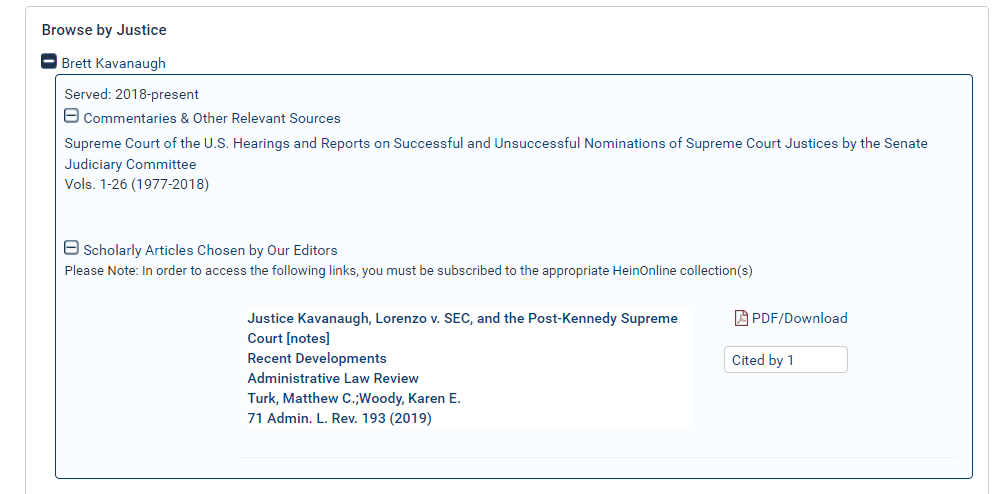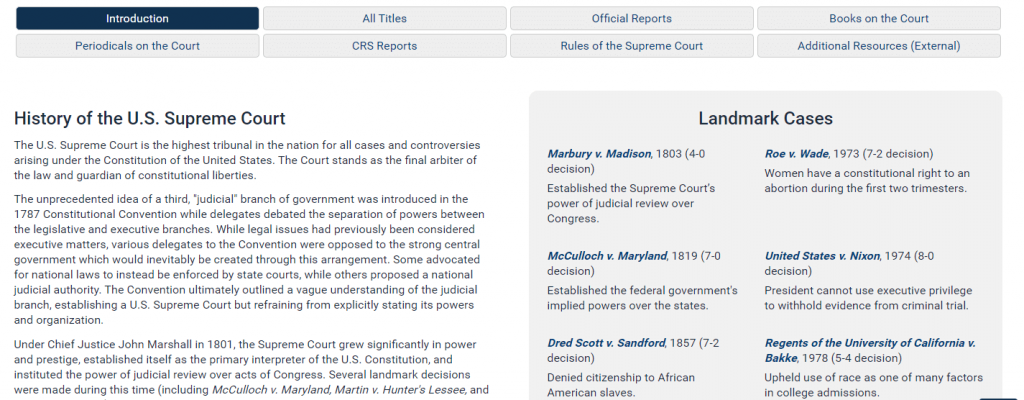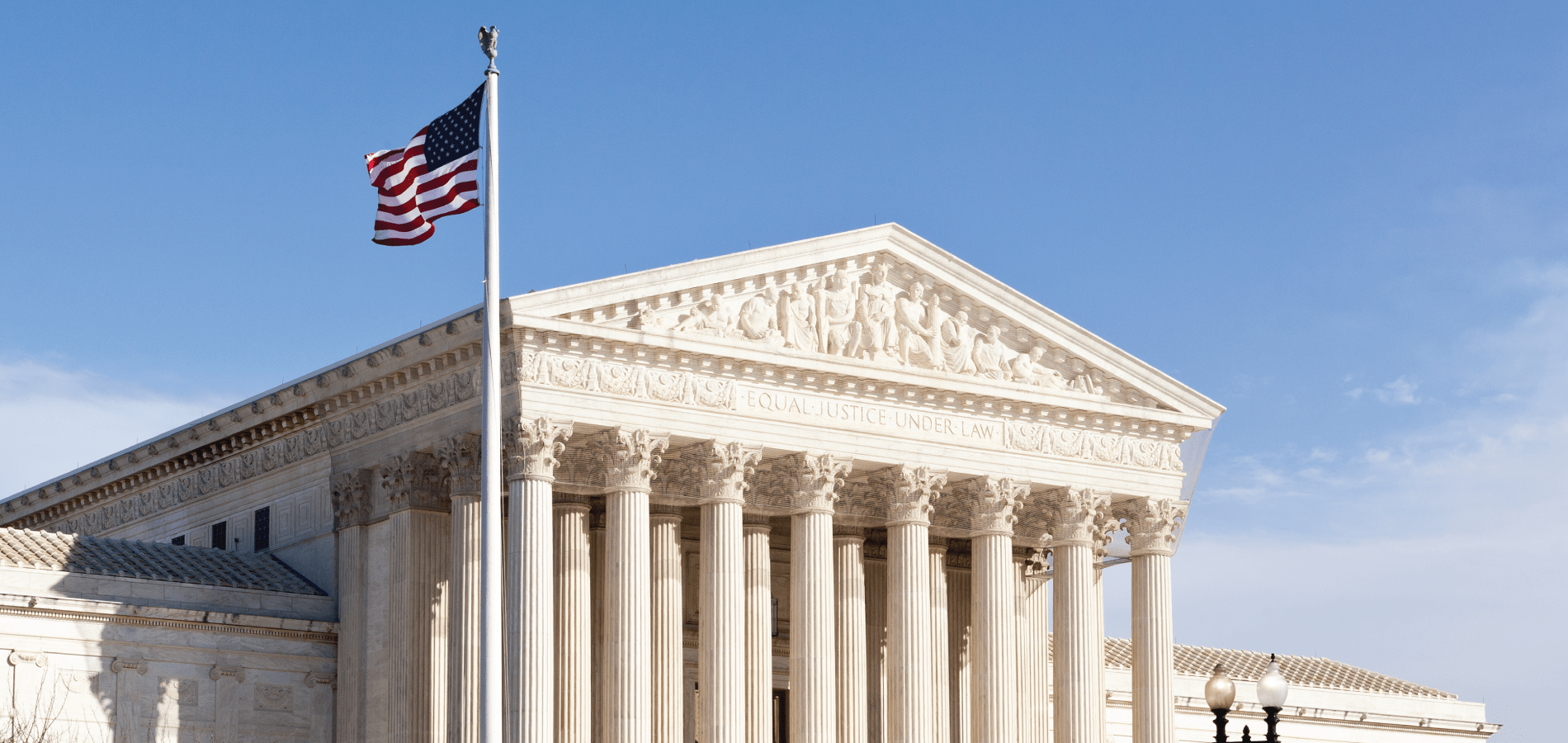The Supreme Court of the United States, otherwise known as SCOTUS, is the highest tribunal in the nation for all cases and controversies arising under the Constitution. It marks the boundaries of authority between state and nation, state and state, and government and citizen. Although SCOTUS receives approximately 7,000-8,000 petitions each term, the justices grant and hear oral arguments for about 80 cases annually. Let’s take a closer look at SCOTUS and see what unique resources you can find in HeinOnline.
Who Makes Up SCOTUS
The Supreme Court was established by Article III of the Constitution. The formation and methodology were first established by the 1st Congress through the Judiciary Act of 1789 and consisted of a chief justice and five associate judges. The size of the Court has been greatly altered over the years. As the nation’s boundaries grew, Congress continued to add justices to match the growing number of judicial circuits. From 1807-1863 the number of judges jumped from seven to ten. However, in 1866, Congress passed the Judicial Circuits Act of 1866, which stated that the next three judges who retired would not be replaced, bringing the number of justices to seven. By 1869, the Circuit Judges Act returned the number of justices to nine, where it stands today.
As a part of the system of checks and balances in the Constitution, the Appointments Clause empowers the president to nominate and appoint justices of the Supreme Court with the advice and consent of the United States Senate. The justices may serve for the remainder of their lives unless they are impeached and convicted by Congress, resign, or retire. When the Chief Justice spot opens, the president may either appoint someone from outside the Court or promote an Associate Justice.
Let’s take a look at the current SCOTUS.
u003ca href=u0022https://heinonline.org/HOL/P?h=hein.supcourt/scursu0039u0026amp;i=1u0022 target=u0022_blanku0022 rel=u0022noreferrer noopeneru0022u003eu003cstrongu003eJohn Robertsu003c/strongu003eu003c/au003e is the Chief Justice who was appointed by G.W. Bush in 2005. He is regarded as a key swing vote within the Court. Roberts succeeded u003ca href=u0022https://heinonline.org/HOL/P?h=hein.supcourt/scursu0015u0026amp;i=1u0022 target=u0022_blanku0022 rel=u0022noreferrer noopeneru0022u003eu003cstrongu003eWilliam Rehnquistu003c/strongu003eu003c/au003e and has authored the majority opinion in several landmark cases.u003cbru003eu003cbru003eu003ca href=u0022https://heinonline.org/HOL/AuthorProfile?action=editu0026amp;search_name=Roberts%2C%20John%20G.%20Jr.u0026amp;collection=journalsu0022 target=u0022_blanku0022 rel=u0022noreferrer noopeneru0022u003eu003cstrongu003eView Author Profile Pageu003c/strongu003eu003c/au003e
u003ca href=u0022https://heinonline.org/HOL/P?h=hein.supcourt/scursu0029u0026amp;i=1u0022 target=u0022_blanku0022 rel=u0022noreferrer noopeneru0022u003eu003cstrongu003eClarence Thomasu003c/strongu003eu003c/au003e is an associate justice who is the longest-serving justice with a tenure of 28 years. He was appointed by G. H. W. Bush in 1991. Thomas succeeded u003ca href=u0022https://heinonline.org/HOL/P?h=hein.supcourt/scursu0007u0026amp;i=71u0022 target=u0022_blanku0022 rel=u0022noreferrer noopeneru0022u003eu003cstrongu003eThurgood Marshallu003c/strongu003eu003c/au003e and is the second African American to serve on the Court. He is viewed as the most conservative justice on the Court and is known for almost never speaking during oral arguments.u003cbru003eu003cbru003eu003ca href=u0022https://heinonline.org/HOL/AuthorProfile?action=editu0026amp;search_name=Thomas%2C%20Clarenceu0026amp;collection=journalsu0022 target=u0022_blanku0022 rel=u0022noreferrer noopeneru0022u003eu003cstrongu003eView Author Profile Pageu003c/strongu003eu003c/au003e
u003ca href=u0022https://heinonline.org/HOL/P?h=hein.supcourt/scursu0035u0026amp;i=1u0022 target=u0022_blanku0022 rel=u0022noreferrer noopeneru0022u003eu003cstrongu003eRuth Bader Ginsburgu003c/strongu003eu003c/au003e is an associate justice who was appointed by Bill Clinton in 1993. Known as “The Notorious RBG,” Ginsburg is the first female Jewish justice to serve on the Court. She succeeded u003ca href=u0022https://heinonline.org/HOL/P?h=hein.supcourt/scursu0006u0026amp;i=293u0022 target=u0022_blanku0022 rel=u0022noreferrer noopeneru0022u003eu003cstrongu003eByron Whiteu003c/strongu003eu003c/au003e. For a brief moment in time, she was the only female justice. Ginsburg typically sides with the more liberal wing of the Court. Learn more about her career in this u003ca href=u0022https://home.heinonline.org/blog/2018/03/celebrating-womens-history-month-ruth-bader-ginsburg-affectionately-known-as-the-notorious-rbg/u0022 target=u0022_blanku0022 rel=u0022noreferrer noopeneru0022u003eu003cstrongu003eblog postu003c/strongu003eu003c/au003e.u003cbru003eu003cbru003eu003ca href=u0022https://heinonline.org/HOL/AuthorProfile?action=editu0026amp;search_name=Ginsburg%2C%20Ruthu0026amp;collection=journalsu0022 target=u0022_blanku0022 rel=u0022noreferrer noopeneru0022u003eu003cstrongu003eView Author Profile Pageu003c/strongu003eu003c/au003e
u003ca href=u0022https://heinonline.org/HOL/P?h=hein.supcourt/scursu0037u0026amp;i=1u0022 target=u0022_blanku0022 rel=u0022noreferrer noopeneru0022u003eu003cstrongu003eStephen Breyeru003c/strongu003eu003c/au003e is an associate justice who was appointed by Bill Clinton in 1994. He specializes in administrative law and has composed several textbooks that remain in use today. Breyer succeeded u003ca href=u0022https://heinonline.org/HOL/P?h=hein.supcourt/scursu0008u0026amp;i=7u0022 target=u0022_blanku0022 rel=u0022noreferrer noopeneru0022u003eu003cstrongu003eHarry Blackmunu003c/strongu003eu003c/au003e and is generally associated with the more liberal side of the Court.u003cbru003eu003cbru003eu003ca href=u0022https://heinonline.org/HOL/AuthorProfile?action=editu0026amp;search_name=Breyer%2C%20Stephenu0026amp;collection=journalsu0022 target=u0022_blanku0022 rel=u0022noreferrer noopeneru0022u003eu003cstrongu003eView Author Profile Pageu003c/strongu003eu003c/au003e
u003ca href=u0022https://heinonline.org/HOL/P?h=hein.supcourt/scursu0043u0026amp;i=1u0022 target=u0022_blanku0022 rel=u0022noreferrer noopeneru0022u003eu003cstrongu003eSamuel Alitou003c/strongu003eu003c/au003e is an associate justice who was appointed by G.W. Bush in 2006. He has been considered one of the most conservatives justices of the Court. Alito succeeded u003ca href=u0022https://heinonline.org/HOL/P?h=hein.supcourt/scursu0014u0026amp;i=1u0022 target=u0022_blanku0022 rel=u0022noreferrer noopeneru0022u003eu003cstrongu003eSandra Day O’Connoru003c/strongu003eu003c/au003e.u003cbru003eu003cbru003eu003ca href=u0022https://heinonline.org/HOL/AuthorProfile?action=editu0026amp;search_name=Alito%2C%20Samuel%20A.u0026amp;collection=journalsu0022 target=u0022_blanku0022 rel=u0022noreferrer noopeneru0022u003eu003cstrongu003eView Author Profile Pageu003c/strongu003eu003c/au003e
u003ca href=u0022https://heinonline.org/HOL/P?h=hein.supcourt/scursu0048u0026amp;i=1u0022 target=u0022_blanku0022 rel=u0022noreferrer noopeneru0022u003eu003cstrongu003eSonia Sotomayoru003c/strongu003eu003c/au003e is an associate justice who was appointed by Barack Obama in 2009. She is the first Hispanic and Latina Justice. Sotomayor succeeded u003ca href=u0022https://heinonline.org/HOL/P?h=hein.supcourt/scursu0027u0026amp;i=1u0022 target=u0022_blanku0022 rel=u0022noreferrer noopeneru0022u003eu003cstrongu003eDavid Souteru003c/strongu003eu003c/au003e and is known for her concern with the rights of defendants and reform of the criminal justice system.u003cbru003eu003cbru003eu003ca href=u0022https://heinonline.org/HOL/AuthorProfile?action=editu0026amp;search_name=Sotomayor%2C%20Soniau0026amp;collection=journalsu0022 target=u0022_blanku0022 rel=u0022noreferrer noopeneru0022u003eu003cstrongu003eView Author Profile Pageu003c/strongu003eu003c/au003e
u003ca href=u0022https://heinonline.org/HOL/P?h=hein.supcourt/scursu0051u0026amp;i=1u0022 target=u0022_blanku0022 rel=u0022noreferrer noopeneru0022u003eu003cstrongu003eElena Kaganu003c/strongu003eu003c/au003e is an associate justice who was appointed by Barack Obama in 2010. Although she is known as a liberal, her rulings fall on the more moderate side. Kagan succeeded u003ca href=u0022https://heinonline.org/HOL/P?h=hein.supcourt/scursu0009u0026amp;i=1u0022 target=u0022_blanku0022 rel=u0022noreferrer noopeneru0022u003eu003cstrongu003eJohn Paul Stevensu003c/strongu003eu003c/au003e and is known for being the first female Solicitor General of the United States.u003cbru003eu003cbru003eu003ca href=u0022https://heinonline.org/HOL/AuthorProfile?action=editu0026amp;search_name=Kagan%2C%20Elenau0026amp;collection=journalsu0022 target=u0022_blanku0022 rel=u0022noreferrer noopeneru0022u003eu003cstrongu003eView Author Profile Pageu003c/strongu003eu003c/au003e
u003ca href=u0022https://heinonline.org/HOL/P?h=hein.supcourt/scursu0055u0026amp;i=1u0022 target=u0022_blanku0022 rel=u0022noreferrer noopeneru0022u003eu003cstrongu003eNeil Gorsuchu003c/strongu003eu003c/au003e is an associate justice who was appointed by Donald Trump in 2017. Gorsuch succeeded u003ca href=u0022https://heinonline.org/HOL/P?h=hein.supcourt/scursu0017u0026amp;i=1u0022 target=u0022_blanku0022 rel=u0022noreferrer noopeneru0022u003eu003cstrongu003eAntonin Scaliau003c/strongu003eu003c/au003e and is known for being an advocate for natural law jurisprudence. He is the first Supreme Court Justice to serve alongside another Justice (u003ca href=u0022https://heinonline.org/HOL/P?h=hein.supcourt/scursu0025u0026amp;i=269u0022 target=u0022_blanku0022 rel=u0022noreferrer noopeneru0022u003eu003cstrongu003eAnthony Kennedyu003c/strongu003eu003c/au003e) for whom he once had clerked.u003cbru003eu003cbru003eu003ca href=u0022https://heinonline.org/HOL/AuthorProfile?action=editu0026amp;search_name=Gorsuch%2C%20Neil%20M.u0026amp;collection=journalsu0022 target=u0022_blanku0022 rel=u0022noreferrer noopeneru0022u003eu003cstrongu003eView Author Profile Pageu003c/strongu003eu003c/au003e
u003ca href=u0022https://heinonline.org/HOL/P?h=hein.supcourt/scursu0057u0026amp;i=1u0022 target=u0022_blanku0022 rel=u0022noreferrer noopeneru0022u003eu003cstrongu003eBrett Kavanaughu003c/strongu003eu003c/au003e is an associate justice who was appointed by Donald Trump in 2018. The Senate Judiciary Committee originally delayed their vote for this appointment due to sexual assault allegations against Kavanaugh. After testimonies from both Kavanaugh and his accuser, the Senate voted to confirm Kavanaugh’s nomination. He succeeded u003ca href=u0022https://heinonline.org/HOL/P?h=hein.supcourt/scursu0025u0026amp;i=269u0022 target=u0022_blanku0022 rel=u0022noreferrer noopeneru0022u003eu003cstrongu003eAnthony Kennedyu003c/strongu003eu003c/au003e and is known for recommending Clinton’s impeachment. Kavanagh was also once a central figure in identifying and confirming judicial nominees during George W. Bush’s term.u003cbru003eu003cbru003eu003ca href=u0022https://heinonline.org/HOL/AuthorProfile?action=editu0026amp;search_name=Kavanaugh%2C%20Brett%20M.u0026amp;collection=journalsu0022 target=u0022_blanku0022 rel=u0022noreferrer noopeneru0022u003eu003cstrongu003eView Author Profile Pageu003c/strongu003eu003c/au003e
Hearing and Deciding Cases
The Court holds oral arguments in about 70-80 cases each year. Hearings are scheduled Mondays through Wednesdays; they begin on the first Monday in October and typically last through April. Each hearing is strictly timed, giving each side 30 minutes to present its case. During this time the justices will ask questions and debate amongst themselves. The courtroom is open to the public with a first-come, first-seated basis. Transcripts are made available for each case by the end of the day. Audio of each argument is made available by Friday of that same week.
The justices meet together privately after the arguments to debate and share their opinions of each case. By the end of the current term, SCOTUS must make a decision; however, the Court is not obligated to release a decision at any set time after an oral argument. As there are only nine justices, a decision is always reached. Once the decision is announced, the opinion of each justice is revealed. The Court’s opinions are published in three stages; first, a slip opinion is made available, then the opinion is bound together in a preliminary print of U.S. Reports, and lastly, it is issued in the final bound volume of U.S. Reports.
The Supreme Court cannot directly enforce its rulings. The law is expected to be used as controlling constitutional doctrine by lower courts. Furthermore, the Court’s decisions can be and have been overturned by constitutional amendments. This has happened five times over the course of history:
- Chrisholm v. Georgia (1793) was overturned by the Eleventh Amendment
- Dred Scott v. Sandford (1857) was overturned by the Thirteenth and Fourteenth Amendments
- Pollock v. Farmers’ Loan & Trust Co. (1895) was overturned by the Sixteenth Amendment
- Minor v. Happersett (1875) was overturned by the Nineteenth Amendment
- Oregon v. Mitchell (1970) was overturned by the Twenty-Sixth Amendment
The Court has also overturned its own decisions in whole or in part hundreds of times, including landmark case such as the following:
- Plessy v. Ferguson (1896) by Brown v. Board of Education (1954)
- Swift v. Tyson (1842) by Erie Railroad Co. v. Tompkins (1938)
- Whitney v. California (1927) by Brandenburg v. Ohio (1969)
- Wolf v. Colorado (1949) by Mapp v. Ohio (1961)
SCOTUS in HeinOnline
HeinOnline includes a wealth of information about both the Supreme Court of the United States and its decisions. Let’s take a look at these valuable resources.
History of Supreme Court Nominations
HeinOnline’s History of Supreme Court Nominations database includes the complete series of Supreme Court of the U.S. Hearings and Reports on Successful and Unsuccessful Nominations of Supreme Court Justices by the Senate Judiciary Committee by Roy M. Mersky and J. Myron Jacobstein, and continued by Tobe Liebert and then William H. Manz. This ongoing series is considered to be the definitive documentary history of the nominations and confirmation process of both successful and unsuccessful nominations to the Court up through Brett Kavanagh.
Each nomination includes relevant materials, such as:
- Confirmation hearing and transcript on the nomination
- Senate Judiciary Committee vote on the nomination
- Memoranda drafted
- Presidential statements
- Resignation announcements
- Pre-nomination speculation
- Nomination announcement
- Confirmation date
The Browse by Justice option allows the user to link directly to relevant content for each justice. Also included are more than 350 titles related to the Supreme Court, links to scholarly articles, and bibliographies.

Preview of United States Supreme Court Cases
Available exclusively through HeinOnline, Preview of the United States Supreme Court Cases is a publication that provides comprehensive expert analysis of all cases granted certiorari before the Supreme Court prior to the arguments. A subscription to this online publication includes eight issues annually. Issues 1-7 summarize the Court’s seven argument sessions from October through April. Issue 8, which is published subsequent to the close of the Court’s term at the end of June, reviews the entire term using statistics, charts, essays, and case summaries.
A case locator tool has been built to enable users to quickly view term information, docket numbers, case names, decided dates, and subjects for each case discussed in Preview of United States Supreme Court Cases. Browse the cases by any of these options, and click any case to open up its database entry. In addition to administrative information such as case name and docket number, entries contain:
- Links to merit briefs
- Links to amicus briefs
- Full print transcripts
- Audio transcripts from Oyez
- Citation and summary information for each case

U.S. Supreme Court Library
HeinOnline’s U.S. Supreme Court Library provides complete coverage of the official U.S. Reports, an indexed compilation of the official full text of all decisions of the Supreme Court of the United States and the official record of its rulings, orders, case tables, and other proceedings. In addition to the U.S. Reports, the 600+ titles in HeinOnline’s U.S. Supreme Court Library include books, periodicals, CRS reports, rules of the Court, and external links. Users can navigate the database using various tools, including HeinOnline’s ScholarCheck, linking to case law with FastCase, and linking to Oyez, a complete and authoritative source for Supreme Court audio.

Even More Content
Subscribe to our blog to get informative blogs just like this delivered to your inbox! To read even more about the Supreme Court and its decisions, check out these recent blog posts:
- Proud to Be Born This Way: A Look Back at the Road to Pride and LGBTQ Rights
- 5 Easy Ways to Research Black History in HeinOnline This Month
- The Enron Corporation: A Tale of Corporate Fraud, Conspiracy, and Corruption
- The Life and Career of Supreme Court Justice Hugo Black
- Coming for Katy Like a Dark Horse: Copyright Law in the U.S.



